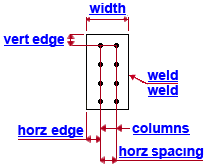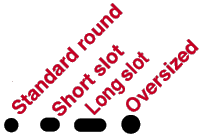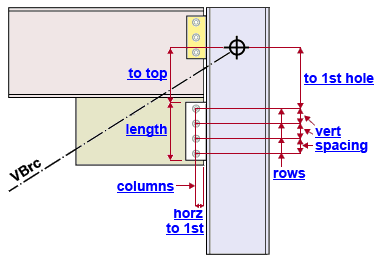"  Shear Tab " connection design locks
Shear Tab " connection design locks
| A single-plate shear connection can be designed per " |
|
||||
|
" |
" (two columns of bolts)  |
|||
|
||||
Please note the following: To get a shear plate shop welded to the column for field bolting the gusset plate to, the beam end that the brace gusset plate shop attaches to must have a shear plate. That beam's shear plate can be combined with the shear plate that field bolts to the gusset plate. On combined shear plates, " Vertical to 1st hole " and " Rows " are the only settings that are shown for the brace. Combined shear plates are designed when " Combine... " is set to ' Yes ' on the beam. For additional control over a combined shear plate, you can use the "
Shear Tab " connection design locks on the Beam Edit window.
Connection Guide: Click here .
User Defined Connections: Settings that are locked (
) in the user defined connection file will automatically be locked on the member edit window. You can, if you so choose, manually lock additional settings on the member edit window, and your changes will be retained, through multiple processes, so long as you do not change to a different connection then switch back to the original user defined connection.
Vertical Brace Edit: To change a setting, first set it to locked (
). Related settings that are unlocked (
) may be updated, and the "
Left/Right end limit state " calculations will be updated. Settings that are locked (
) will not be changed by connection design , even if doing so might prevent a connection failure.
Connection design locks :
| Locks not dimensioned or called out on the drawing are marked ( not depicted ). For combined shear plates, " Work point ... " and " Rows... " are the only settings shown. |
![]() Shear Tab
Shear Tab
(vertical brace to beam & column)
Shear plate
Top of plate ( to top ): The distance (parallel with the work line of the supporting column) from the work point of the vertical brace to the top edge of the shear plate. This dimension is shown in the example on the left. This distance is vertical if the column is non-sloping.
Plate length ( length ): The distance between the top edge of the shear plate and the bottom edge of the shear plate. The "length" is dimensioned in the example on the left. This distance is vertical if the column is vertical. So long as this field is left unlocked (
), changing the number of " Rows " or the " Vertical hole spacing " also changes the " Plate length ."
Plate width ( width ): The distance between the two vertical edges of the shear plate. Since the shear plate is rectangular, this is also the length of either the top edge or the bottom edge of the shear plate. The "width" is dimensioned in the example on the right.
Plate thickness ( not depicted ): The " Material thickness " of the shear plate.
Bolts
Bolt diameter ( not depicted ): The diameter of bolts to be used for field bolting the gusset plate to the shear plate. You can either type in any diameter (inches or mm), or you can select a bolt diameter from the combo box (
). The diameters that are listed in the combo box come from Home > Project Settings > Job > Bolt Settings > the " Available bolt diameters " list. The bolt diameter entered here, together with the " Hole type ," set the diameter of holes the bolts go into.
Hole type ( not depicted ): Standard round or Short slot or Oversized or Long slot or User slot #1 or User slot #2 . The hole type selected here, together with the " Bolt diameter ," set the diameter of holes for field bolting the shear plate to the gusset.

Rows: The number of holes in any column of holes in the shear plate. All hole columns have the same number of rows -- see example. Bolt row spacing runs parallel with the work line of the column (vertically if the column is vertical). In both of the examples shown above, the number of " Rows " is ' 4 '. If you change the number of " Rows of bolts ," an " Plate length " is unlocked (
), the length of the shear plate is automatically recalculated. As noted above , this is one of only two connection design locks that are available on the brace if, on the Beam Edit window, the beam and brace shear plates are set to " Combine... "
Vertical to 1st hole ( to 1st hole ): The distance (parallel with the length of the shear plate and the work line of the column) from the work point of the vertical brace to the center of the nearest hole in the shear plate. See the example on the left. This distance is vertical if the column is non-sloping. As noted above , this is one of only two connection design locks that are available on the brace if, on the Beam Edit window, the beam and brace shear plates are set to " Combine... "
Vertical hole spacing ( vert spacing ): The distance (center to center) between any two adjacent holes in the same column of holes in the shear plate. See the example on the left. If you change the " Vertical hole spacing ," and " Plate length " is unlocked (
), the length of the plate is automatically recalculated. Alternative : Instead of entering a single hole spacing distance, you can enter variable hole spacing. See the video and table below.
VIDEO 
Variable hole spacing can be typed to locked " Vertical hole spacing " fields found in leaves named " Shear Tab " "
Bent Plate " "
End Plate " and "
NS/FS Clip ."
Rows Spacing Result 5 3,5,3,3 4 spaces at 3", 5", 3" and 3" 5 3,5,2@3 4 spaces at 3", 5", 3" and 3" 5 3,5,3 4 spaces at 3", 5", 3" and 3"
(the last spacing -- 3 -- is repeated to fill the spaces that are required for the number of rows)5 3,5,3,3,2,3 End connection failure message (see below). End connection failure message: Variable row spacing specifies too many rows
Vertical edge distance ( vert edge ): The distance from the top edge of the shear plate to the top row of holes. This distance is dimensioned in the example on the right.
Columns: The number of columns of holes to be used for field bolting the shear plate to the gusset plate. In the example to the left, the number of " Columns " is ' 1 '. In the example to the right, the number of " Columns " is ' 2 '.
Horizontal to 1st hole ( horz to 1st ): The distance (perpendicular to the length of the shear plate) from the edge of the gusset plate nearest the column to the center of the first column of holes on the shear plate. See the example on the left.
Horizontal hole spacing ( horz spacing ): This is the spacing (center to center) between columns of holes in the shear plate. Column hole spacing runs perpendicular to the work line of the column (horizontally if the column is vertical). In the example on the left, the " Horizontal hole spacing " is ' 0 ' since there that shear plate has only one column of holes.
Horizontal edge distance ( horz edge ): The distance (perpendicular to the length of the shear plate) from the edge of the shear plate that is opposite to the edge that welds to the column to the center of the nearest column of holes. See the example on the right.
Primary weld type: None or Double fillet or Single bevel groove or Groove w/ backing bar .
symbol name weld used for... 
fillet General welding of material. 
bevel groove General full penetration welding of material. Primary weld size ( weld ): The primary weld size used to shop weld the shear plate to the column. See the example on the right.
Secondary weld type: None or Double fillet or Single bevel groove or Groove w/ backing bar .
symbol name weld used for... 
fillet General welding of material. 
bevel groove General full penetration welding of material. Secondary weld size ( weld ): The secondary weld size used to shop weld the shear plate to the column.








